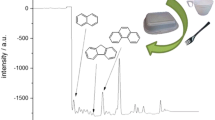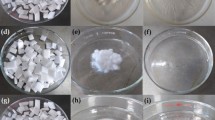Abstract
Residual chlorofluorocarbons (CFCs) and water-extractive residues in expanded polystyrene ware were determined because of the threat to environmental and public health arising from the ozone depleting potential of CFCs and the leaching of toxic monomers and oligomers into food and drink. Chlorofluorocarbon in expanded polystyrene ware was analysed using headspace gas chromatography in the flame ionization mode, and confirmed by gas chromatography-mass spectrometry. The amount of extractive residue leached from this type of polymeric material was determined using an aqueous medium simulating categories of food and beverages. A wide range of concentrations of CFC-12 (dichlorodifluorocarbon) was detected in the styrofoam ware. It fluctuated between a low of 32 ppm and a high of 35471 ppm in two different samples of styrofoam plates. Similarly, the highest and lowest levels of extractive residue detected in two different styrofoam plates were 54 ppm and 0.5 ppm respectively. CFC-22 or HCFC (chlorodifluorocarbon) was absent from these expanded polystyrene ware. The continued use of chlorofluorocarbons as a blowing agent will further exert a deleterious effect on the stratospheric ozone layer. Though the level of water extractive residue from these expanded polystyrene ware was relatively safe, public health could be further safe-guarded through improvmeents in raw material selection and mode of production.
Similar content being viewed by others
References
Boyer et al.: 1970, ‘Styrene Polymers’ in Encyclopaedia of Polymer Science and Technology, Vol. 13, pp. 128–447 (Interscience, New York).
Cooper, P.: 1980, ‘Styrene and the Chromosome’, B.I.B.R.A. Bull., 19, 6.
Coulter et al.: 1971, ‘Styrene and Related Monomers’ in Vinyl and diene Monomers, Vol. 2, pp. 479–576, Wiley-Interscience, New York.
Crompton, T. R.: 1979, ‘Polystyrene and its Copolymers’ in Additive Migration from Plastics into Food, p. 5, (Pergamon Press, United Kingdom).
Farman, J. C., Gardiner, B. G., and Shanklin, J. D.: 1988, ‘How Deep is an Ozone Hole’, Nature, 336, 198.
Fraser, P. J.: 1989, ‘Chlorofluorocarbons and Stratospheric Ozone’, Chemistry in Australia, 56, 272–275.
Frados, J.: 1976, Plastic Engineering Handbook of the Society of Plastic Industry, 909 pp, Van Nostrand, Reinhold, U.K.
Glenny, M.: 1987, ‘Ozone at Ground Level Threatens Human Health’, New Scientist, 5th March, p. 17.
Gras, J. L. and Ayers, G. P.: (1983), ‘Marine Aerosol at Southern Mid-Latitude’, J. Geoph. Res. C., 88, 10661–10666.
Houghton, R. A. and Woodwell, G. M.: 1989, ‘Global Climatic Change’, Scientific America, 260, 18–26.
Milne, R.: 1989, ‘Arctic Hole Eludes Ozone Investigators’, New Scientist, 21st January, p. 24.
Molina, M. J. and Rowland, F. S.: 1974, ‘Stratospheric Sink for Chlorofluoromethane: Chlorine Atomic-Analysed Destruction of Ozone’, Nature, 249, 810.
Sam, C. T. and Chua, T. H.: 1989, ‘Chlorofluorocarbon (CFC) Determination in Styrofoam Ware by Headspace Gas Chromatography and GC-Mass Spectrometry’, Bull. Singapore Natl. Inst. Chem. 17, 65–70.
Sam, C. T. and Chua, T. H.: 1990, ‘Residual Blowing Agent and Styrene Monomer in Disposable Food-Contact Polystyrene Ware’, in Proceedings of 7th Symposium on Advances in Food Analysis and Food Safety, Singapore Institute of Food Science and Technology.
Sax, N. I.: 1984, ‘Styrene’ in Dangerous Properties of Industrial Materials, 6th ed., p. 940, (Van Nostrand Reinhold Co., New York.
Szivos, J. E.: 1984, ‘Resinous and Polymeric Coatings’ in Code of Federal Registration, Vol. 21, Pt. 175.300, pp. 141–156.
Titus, J.: 1986, Effects of Changes in Stratospheric Ozone and Global Climate, 1, 379 pp. (Overview, USE.P.A.).
Tolbert, M. A., Rossi, M. J., Malhotra, R. and Golden, D. M.: 1987, ‘Reaction of Chlorine Nitrate with Hydrogen Chloride and Water at Antarctic Stratospheric Temperatures’, Science, 238, 1258.
Varner, S. L. and Breder, C. V.: 1981, ‘Headspace Sampling and Gas Chromatographic Determination of Styrene Migration from Food-Contact Polystyrene Cups into Beverages and Food Simulants’, J. Assoc. Off. Anal. Chem., 64, 1122–1130.
Wilen, et al.: 1961, ‘Multistep Synthesis Starting with 1-phenyl-ethanol and Leading to Polystyrene’, J. Chem. Ed., 38, 304.
Willem, J. B. and Pearman, G. I.: 1989, ‘Greenhouse Gases and the Greenhouse Effect’, Chemistry in Australia, 56, 268–271.
Author information
Authors and Affiliations
Rights and permissions
About this article
Cite this article
Sam, C.T., Chua, T.H. The determination of chlorofluorocarbons and extractives in the expanded and disposable polystyrene ware. Environ Monit Assess 19, 413–422 (1991). https://doi.org/10.1007/BF00401329
Issue Date:
DOI: https://doi.org/10.1007/BF00401329




